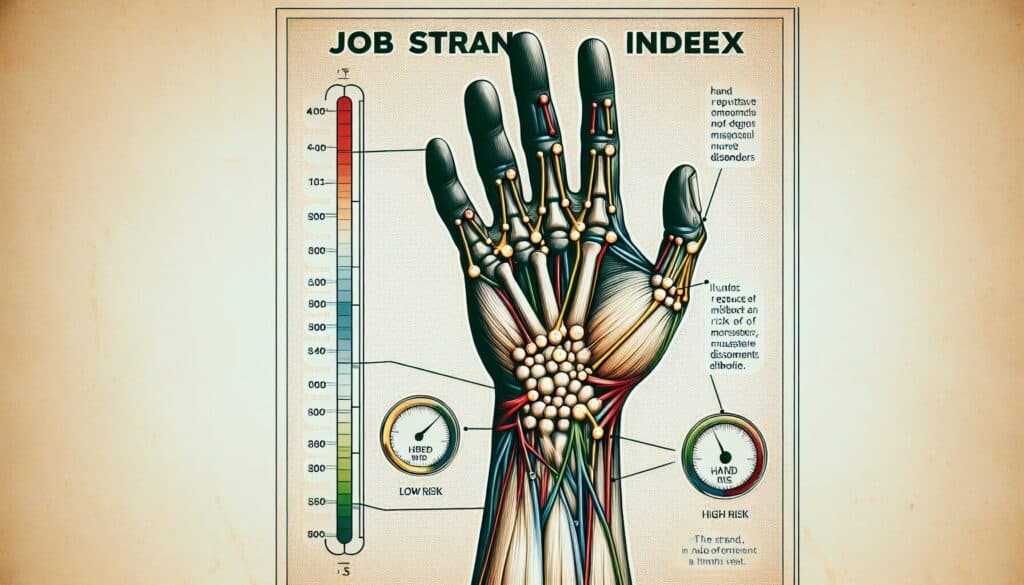Método para evaluar el riesgo de trastornos musculoesqueléticos de la mano, la muñeca, el antebrazo y el codo, asociados principalmente a esfuerzos repetitivos y enérgicos.
- Metodologías: Ergonomía
Índice de tensión en el trabajo (JSI)

Índice de tensión en el trabajo (JSI)
- Mejora continua, Ergonomía, Ciencias de la Salud, Human Factors, Manufactura esbelta, Mejora de procesos, Gestión de calidad, Gestión de riesgos, Seguridad
Objetivo:
Cómo se utiliza:
- Calcula una puntuación basada en la intensidad del esfuerzo, la duración del esfuerzo por ciclo, los esfuerzos por minuto, la postura de la mano/muñeca, la velocidad del trabajo y la duración de la tarea por día. Una puntuación por encima de un umbral indica un trabajo peligroso.
Ventajas
- Relativamente sencillo y rápido de aplicar una vez recopilados los datos; se centra en los factores de riesgo clave de los trastornos distales de las extremidades superiores; proporciona una única puntuación de riesgo.
Contras
- Considera un número limitado de factores de riesgo; puede no ser adecuado para todos los tipos de tareas de las extremidades superiores; se basa en la estimación subjetiva de algunos factores.
Categorías:
- Ergonomía
Ideal para:
- Evaluación del riesgo de desarrollar trastornos musculoesqueléticos en las extremidades superiores distales debido a las tareas laborales.
The Job Strain Index (JSI) is particularly beneficial in various sectors that involve manual labor, such as manufacturing, construction, healthcare, and warehousing, where workers are susceptible to musculoskeletal disorders. This methodology is most effectively applied during the ergonomics assessment phase of workplace design or during the evaluation of existing job tasks to identify risks associated with specific work activities. It is typically initiated by occupational health and safety professionals, ergonomists, or human factors specialists, often in collaboration with workers, supervisors, and management to ensure a comprehensive understanding of job demands and work environments. The process includes observational studies and data collection on workers’ tasks, thereby engaging different stakeholders in the evaluation process, including engineers looking to improve estación de trabajo designs and occupational therapists assessing the impact of job requirements on individual health. The JSI score serves as a quantifiable measure that can drive interventions, such as redesigning tasks to minimize risk factors, implementing job rotation strategies, or offering training to modify manual handling techniques. Its user-friendly nature allows for quick on-site evaluations, making it a practical tool during safety audits or in the development of workplace initiatives that aim to enhance worker well-being while maintaining productivity standards. By providing a clear numerical risk assessment, JSI aids in prioritizing actions needed for improvement, offering a straightforward approach to risk management in operational settings.
Pasos clave de esta metodología
- Determine the intensity of exertion for each task using a standardized scale.
- Evaluate the duration of exertion per cycle for each identified task.
- Count the number of efforts applied per minute for relevant tasks.
- Assess hand/wrist posture during each task using defined criteria.
- Measure the speed of work for each task as part of the analysis.
- Estimate the duration of the task performed each day.
- Calculate the Job Strain Index score by combining all the assessed parameters.
- Compare the calculated score against established threshold values to determine risk level.
Consejos profesionales
- Integrate task observations with JSI calculations to capture real-world variations in exertion levels and to inform design adjustments.
- Utilize the JSI data as a baseline for iterative design changes and re-evaluate periodically to track the effectiveness of ergonomic interventions.
- Collaborate with multidisciplinary teams to assess context-specific variables such as environment and workflow, enhancing the accuracy of the JSI application.
Leer y comparar varias metodologías, recomendamos el
> Amplio repositorio de metodologías <
junto con otras más de 400 metodologías.
Sus comentarios sobre esta metodología o información adicional son bienvenidos en la dirección sección de comentarios ↓ , así como cualquier idea o enlace relacionado con la ingeniería.
Contexto histórico
1986
(si se desconoce la fecha o no es relevante, por ejemplo "mecánica de fluidos", se ofrece una estimación redondeada de su notable aparición)

Publicaciones relacionadas
Gestión de operaciones de fabricación (MOM)
Sistema de Ejecución de Fabricación (MES)
Plan de control de la fabricación
Pruebas manuales
Tablas de evaluación de la manipulación manual (MAC)
ManTRA (Herramienta de evaluación de riesgos en las tareas manuales)